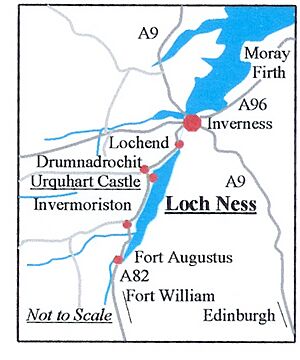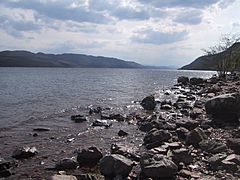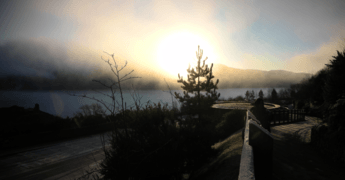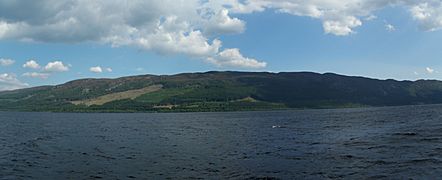Loch Ness facts for kids
Quick facts for kids Loch Ness |
|
|---|---|
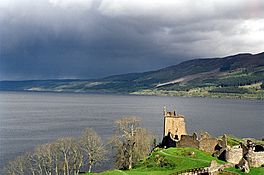
With Urquhart Castle in the foreground
|
|
| Location | Scottish Highlands |
| Coordinates | 57°18′N 4°27′W / 57.300°N 4.450°W |
| Type | freshwater loch, oligotrophic, dimictic |
| Primary inflows | River Oich/Caledonian Canal, River Moriston, River Foyers, River Enrick, River Coiltie |
| Primary outflows | River Ness/Caledonian Canal |
| Catchment area | 1,770 km2 (685 sq mi) |
| Basin countries | Scotland, United Kingdom |
| Max. length | 36.2 km (22.5 mi) |
| Max. width | 2.7 km (1.7 mi) |
| Surface area | 56 km2 (21.8 sq mi) |
| Average depth | 132 m (433 ft) |
| Max. depth | 226.96 m (124.10 fathoms; 744.6 ft) |
| Water volume | 7.5 km3 (1.8 cu mi) |
| Surface elevation | 15.8 m (52 ft) |
| Islands | 1 (Cherry Island) |
| Settlements | Fort Augustus, Invermoriston, Drumnadrochit, Abriachan, Lochend; Whitebridge, Foyers, Inverfarigaig, Dores. |
Loch Ness is a very large freshwater lake in the Scottish Highlands. It stretches for about 37 kilometers (23 miles) southwest of Inverness. The loch gets its name from the River Ness, which flows from its northern end.
Loch Ness is famous for stories about the Loch Ness Monster, often called "Nessie." The water in the loch is quite dark because of a lot of peat (decayed plant matter) in the surrounding soil. This makes it hard to see very far into the water.
Loch Ness is the second largest Scottish loch by surface area. But because it is so deep, it holds the most water in Great Britain. Its deepest point is about 230 meters (755 feet). This makes it the second deepest loch in Scotland. It holds more water than all the lakes in England and Wales put together!
Contents
Geography of Loch Ness
Loch Ness is a long, narrow freshwater lake in the Scottish Highlands. It stretches for about 37 kilometers (23 miles) from southwest to northeast. It covers an area of about 56 square kilometers (21.8 square miles).
The loch's deepest point is around 230 meters (755 feet). This makes it the second deepest loch in Scotland. Its surface is about 16 meters (52 feet) above sea level. Loch Ness is the biggest body of water in the Great Glen. This valley runs from Inverness in the north to Fort William in the south.
Loch Ness sits along the Great Glen Fault. This is a natural crack in the Earth's crust. Over time, glaciers carved out this weakness, forming the Great Glen and the basins for Loch Ness and other lochs.
Cherry Island: An Ancient Island
Loch Ness has one small island called Cherry Island. It is located at the southwestern end of the loch. This island is actually man-made, known as a crannog. It was likely built during the Iron Age, thousands of years ago.
Cherry Island was once larger, but its size changed when the water level rose. This happened when the Caledonian Canal was built in the early 1800s. A castle stood on Cherry Island in the 15th century. It was probably used as a strong, safe place.
Water Flow and Connections
The water in Loch Ness is very dark. This is because of the high amount of peat in the soil around it. This peat makes the water visibility very low.
The southern end of Loch Ness is fed by the River Oich. This river flows from another loch called Loch Oich. The northern end of Loch Ness flows out through the Bona Narrows into Loch Dochfour.
The River Ness then flows from Loch Dochfour. It eventually leads through Inverness to the North Sea via the Moray Firth. Loch Ness is also part of the Caledonian Canal. This canal is a waterway that connects the east and west coasts of Scotland.
Villages and Places Around the Loch
| Shore | Places |
|---|---|
| Northern |
|
| Western |
|
| Eastern |
|
| Southern |
In the village of Drumnadrochit, you can find the "Loch Ness Centre and Exhibition." This center teaches visitors about the natural history of the loch. It also shares information about the famous legend of the Loch Ness Monster.
Many boat tours operate from different spots on the loch. These tours give visitors a chance to explore the water and look for "Nessie."
Urquhart Castle is a famous ruin located on the western shore. It is about 2 kilometers (1.2 miles) east of Drumnadrochit. There are also lighthouses at both ends of the loch.
Etymology: How Loch Ness Got Its Name
Loch Ness gets its name from the River Ness. This river flows out of the loch's northern end. The name "Ness" probably comes from an old Celtic word. This word meant 'roaring one'.
There are also old Scottish legends about how the loch got its name. One story tells of a magical spring that overflowed. This happened when a woman forgot to cover it, creating the loch. People then cried out, "There's a loch now!" in their language.
Another legend connects the loch to an Irish woman named Deirdre. She was known as the most beautiful woman of her time. She married a man named Noais by the loch. The loch and river were then named after him.
The Loch Ness Monster
Loch Ness is most famous for the legend of the Loch Ness Monster. This creature is also known as "Nessie." It is said to be a large, unknown animal living in the loch.
Nessie is similar to other mysterious lake monsters reported in Scotland and other places. However, descriptions of Nessie can vary. People's interest and belief in the monster have changed over time. The legend first became widely known in 1933.
Fish Species in Loch Ness

Loch Ness is home to several types of fish. Some fish, like perch and roach, have been brought into the loch or the Caledonian Canal.
| European eel |
| Northern pike |
| European sea sturgeon (possibly in connected waters) |
| Three-spined stickleback |
| Brook lamprey |
| Eurasian minnow |
| Atlantic salmon |
| Sea trout |
| Brown trout (including a type called ferox trout) |
| Arctic char |
Hydroelectricity: Power from Water
Loch Ness is used to help create electricity. It acts as a lower storage area for the Foyers hydroelectric scheme. This system uses water to generate power. It opened in 1975.
A smaller power station nearby used to power an aluminum factory. Now, it generates electricity for the main power grid. Another project, the Glendoe Hydro Scheme, started in 2009. These projects use the power of water to create clean energy.
Records and Achievements
Many people have tried to set records on Loch Ness.
In 1952, John Cobb sadly died while trying to break the water speed record. His boat hit something in the water. There is a memorial to him near the loch.
On August 31, 1974, David Scott Munro became the first person to water ski the entire length of Loch Ness. He covered 48 miles in 77 minutes.
In July 1966, Brenda Sherratt was the first person to swim the length of the loch. It took her over 31 hours to complete this amazing swim.
More recently, in September 2022, swimmer Ross Edgley tried to complete the world's longest non-stop open water swim in Loch Ness. He swam for over 52 hours before he had to stop due to health reasons.
Gallery
-
Locks on Caledonian Canal in Fort Augustus, Loch Ness in the background
-
Sunrise over Loch Ness, taken at Urquhart Castle
Images for kids
See also
 In Spanish: Lago Ness para niños
In Spanish: Lago Ness para niños



